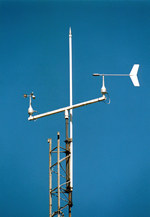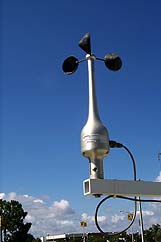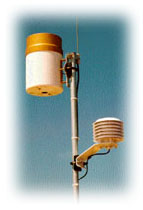|
|
|
Meteorological Station
Information Monitors collects meteorological data to support its activities in Cocoa, Florida
(28.4 N, 80.8 W). Eighteen years of data are available from our previous station in Cape Canaveral,
FL, and since 1995 at our current site. Please note that this is
research data, being collected automatically every 6-minutes. We attempt to keep the data as
accurate as possible but we make no waranty on the accuracy of this data.
|
 |
Data Acquisition System
A Campbell CR10 data logger is used to sample all transducers at 10 second intervals. The measurements are averaged
over a 6-minute interval and stored in the data logger. An automated process on the central computer system
runs every 6 minutes, retrieving, processing, and storing the data into a database. Multiple reports used by
various applications are also automatically generated . The following measurements are recorded at this site:
- Wind speed average (10 meter tower)
- Maximum wind gust
- Wind direction (10 meter tower)
- Dry-bulb temperature
- Dew point temperature
- Barometric pressure
- Precipitation
- Total horizontal solar radiation
- Total solar radiation on a tilted plane
- Direct normal solar radiation
- Total normal solar radiation
- Total horizontal infrared sky radiation
Dry-bulb, dew point, and barometric pressure are recorded once every
six minutes. Precipitation is summed continuously and the total in every
six minute period is recorded. The other measurements are made once every
second and a six minute average is recorded. The recorded maximum wind
gust is the highest of these one second readings.
The meteorological measurements are made with
sensors and translators made by Weather Measure Corp. The sensor types
and accuracies are listed below:
| Parameter |
Sensor |
Accuracy |
| Wind speed |
3 cup anemometer
photon coupled chopper
0.5 mph threshold |
+ 0.15 mph or 1% |
| Wind direction |
light-weight vane
low torque potentiometer
0.5 mph threshold |
0.5% linearity |
| Dry-bulb temperature |
platinum resistance thermometer (RTD) |
+ 0.1 degree C |
| Dew point temperature |
chilled mirror system with
platinum resistance thermometer |
+ 0.3 degree C |
| Barometric pressure |
piesoresistive element (kPascal) |
0.08% of reading |
| Precipitation |
tipping bucket
0.01 inch resolution |
0.5% at 0.5 in/hr |
The dry-bulb temperature sensor is mounted in a motor aspirated radiation
shield. The barometric pressure sensor is located 17 feet above mean sea
level. The precipitation gage is protected by an alter type wind screen.
All sensors and translators are calibrated at least annually.
Wind Velocity
Wind speed and direction are measured using a three cup anemometer and a vane
at a height of 10 meters above the ground.
This is the standard height for meteorological wind measurements.
A special "photo-chopper" design is used in the anemometer (wind speed)
to enable it to measure wind as slow as 0.2 meters per second (one half
of a mile per hour). |
 |
 |
Precipitation
Rainfall is measured by a tipping bucket rain gauge. Rain is collected
in a funnel and alternately fills two small cups (buckets). These two cups
are attached together and placed on a pivot such that when one fills up,
the assembly tips to the side. At each tip, the full cup is emptied and
the empty cup is placed under the funnel. |
Air Temperature
Air temperature is measured with a platinum resistance thermometer. This
is a very accurate temperature measuring device. It is placed in a long
tube which has been painted white on the outside to reflect solar radiation.
A small blower pulls ambient air into the tube and across the thermometer.
This allows measurement of the true air temperature without the effect
of solar heating.
|

|
|


